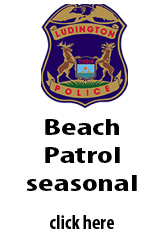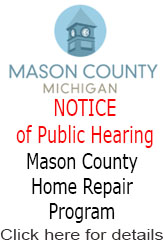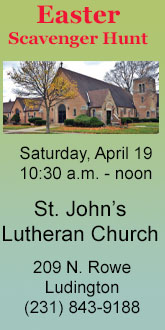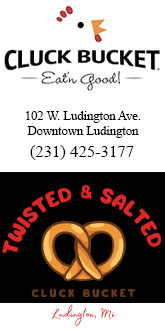 FYI: How roads and streets are numbered in Mason County
FYI: How roads and streets are numbered in Mason County
FYI is a series that discusses how things work in our lives here in Mason County. Click here to see past articles.
By Rob Alway, Editor-in-Chief
Do you know how to find a street address in Mason County without GPS? Every county, city, and village has a different street numbering system.
We’ll start with Mason County’s rural road numbering system. In Mason County all roads lead to Scottville. Though Scottville is not in the exact center of the county, it is where the numbering system beings. Mason County is not an exact square, like some counties, because of the shoreline. If it were an exact square, the geographical center of the county would be at the intersection of US 31 and Decker Road. In Michigan, square townships are 36 square miles (six miles by six miles). Some of Mason County’s townships are not square, however, due to bodies of water such as Lake Michigan (Grant, Hamlin, Pere Marquette, and Summit), and the Pere Marquette River (Amber and Riverton).
In Mason County, every mile of rural road consists of 800 numbers, beginning at the intersection of State Street (US 10) and Main Street (formerly US 31) in Scottville. Since Scottville is an incorporated city and has its own street numbering system, the rural numbering system begins at its city limits.
The first mile east or west of US 31 (north of Scottville) or Scottville Road (south of Scottville) and the first mile east or west of US 10 is the zero block. This zero block (numbers are listed from 0 to 799), goes from US 31/Scottville Road east to Darr Road and west to LaSalle Road, south to First Street and north to… well, the only road one mile north of US 10 is Bryant Road in Pere Marquette Township (one mile from Jebavy Drive west to Washington Avenue) which is also partially in the City of Ludington) and Filburn Road (half mile from Bean to Tuttle roads) in Custer Township and two small segments near Long Lake in Branch Township. Johnson Road, however, is half mile from US 10 and begins in the 400 block north.
 Properties on the north and east sides of the road are even-numbered addresses. Properties on the south and west sides of the road are odd-numbered addresses.
Properties on the north and east sides of the road are even-numbered addresses. Properties on the south and west sides of the road are odd-numbered addresses.
Rural addresses are determined by the county equalization department. Sarah Keegstra is the deputy director of the equalization department and explained how an address is assigned to a property.
She said the first step is for the property owner to fill out a form that includes the legal description of the property. Once an address is determined that form is filed and also forwarded to Mason-Oceana 911.
She sad an address is based on the parcel’s distance to the township section line. A section is one square mile (except for the sections near bordering waterways as described above).
“I ask the property owner to show us where the driveway is going to be located. From there, I find the closest section line, using the county plat book.”
 A plat book is created every two years and lists all rural properties and their owners. It can be purchased at the Mason County Treasurer’s Office at the courthouse, Michigan State University Extension (located in the Recreation Center at West Shore Community College), or the Mason-Lake Conservation District Office, 655 N. Scottville Rd., Scottville. You’ll find the block numbers of the roads listed on the side and bottom on each page. Those block numbers are also located on the official Mason County road map available for free at the Mason County Road Commission in Scottville. It can also be downloaded here.
A plat book is created every two years and lists all rural properties and their owners. It can be purchased at the Mason County Treasurer’s Office at the courthouse, Michigan State University Extension (located in the Recreation Center at West Shore Community College), or the Mason-Lake Conservation District Office, 655 N. Scottville Rd., Scottville. You’ll find the block numbers of the roads listed on the side and bottom on each page. Those block numbers are also located on the official Mason County road map available for free at the Mason County Road Commission in Scottville. It can also be downloaded here.
The distance between the driveway and the section line is then divided by a certain number with the sum being the street address. That address may be tweaked based on which side of the street the property is located.
In 2023, it’s taken for granted that rural properties have road addresses. But, the concept of a rural road address is less than 50 years old. The concept of living on a named road is only 75 years old.
You can thank your firefighters for naming the county roads and for starting the process of providing road addresses to properties.
In 1947, the Mason County Board of Supervisors (now known as the Board of Commissioners) created a Mason County fire department. Prior to World War II only the cities of Ludington and Scottville had fire departments. To offset the cost of those two cities’ taxpayers of paying for countywide fire protection, the county bought three fire trucks. One housed in Ludington, one in Scottville and one housed at the newly created Custer Township Fire Department. Other municipalities were also organizing fire departments that year including Hamlin Township, Riverton Township and Summit Township along with a department that served the Fountain area.
In February 1948, Scottville Fire Chief Oliver Reeds was elected county fire chief with Ludington Fire Chief Arthur Lange as assistant county chief. During the county fire department’s inaugural meeting, held at Scottville City Hall on Feb. 16, 1948, the firefighters discussed the need to name all the county roads and numbering farms.
In October 1948, the county Board of Supervisors, the Mason County Road Commission and the county surveyor, Robert Lunde, started formulating a plan to name the county roads. Their plan was slightly different than the later outcome. At that time, there was also a plan to assign addresses to farms and residences, but that didn’t fully get implemented for another three decades.
According to an Oct. 1, 1948 article in the Ludington Daily News, the “long” east-west roads would be numbered based on its distance from US 10. Fountain Road, for example, was going to be called Five Mile Road. The article didn’t quite explain how the roads on the north side of US 10 would be identified differently than the roads on the south side of US 10.
The naming included input from the townships as many of the roads in the “resorts” areas were already named, most likely around the various lakes. Eventually, the roads were named as they are now, mostly after a particular pioneer farming family that lived along that road (we will have more stories in the future about naming the roads).
Before the roads were formally named, many had unofficial names. People would describe the location of their residence based on an intersection or a close-by farm. Stiles Corners, for instance, was now the intersection of Stiles and Hansen roads. The road that led north from that intersection was just called the Stiles corner road. Kings Corners was the intersection of US 31 and Fountain Road. The road that led into Fountain was the Kings corner road. Free Soil Road was the Pelton Corner road.
In July 1977, the Mason County Board of Commissioners adopted an ordinance, that went into effect on Dec. 1, 1977, requiring the county equalization department to assign numbers to residences. The process was not quick.
“There will be no magic wand and all of a sudden now numbers,” County Equalization Director Leonard Noel said, quoted in a Nov. 1, 1977 LDN article.
The ordinance was adopted to assist with emergency services, public utilities, township officials, county administrative services, and the postal service. Prior to addresses, rural postal carriers would deliver mail based on a rural route (which they still do). However, that was all the information you needed to get your mail: John Smith, Route 3, Ludington, Michigan (notice no ZIP code. Those came later and that, too, is another article). Rural mail carriers just knew who the residences were on their mail route.
Though rural roads didn’t receive names until after World War II and numbers until the Carter administration, the county’s two cities and most of the villages did already have named streets with numbered addresses. This was standard for incorporating a village or city. However, street addresses don’t always make sense.
In the City of Scottville, just like with the county system, the intersection of State and Main streets (US 10 and formerly US 31), is where the numbering system begins. Mostly, the numbers go up to 100 each block. Downtown, for example, is the 100 block of Main Street, either north or south and this continues on Main Street in both directions up to the 500 block. East of the main intersection, the numbering system stays consistent. But, various blocks on the west side of town do not line up. This is likely due to the time when that particular part of town was platted.
In Ludington, ground zero is the intersection of Ludington Avenue and James Street, except for the Fourth Ward (we’ll get back to that). The 100 block of Ludington Avenue, east or west, begins at James Street and the 100 block of James Street, north or south, begins at Ludington Avenue. This continues block by block in all four directions. But, when you cross the bridges into the Fourth Ward, the pattern changes. Washington Avenue and Madison Avenue continue with the downtown numbering system, but the other north-south streets in the Fourth Ward begin at First Street while the east-west streets began at Washington Avenue. This is because at one time, though it was in the City of Ludington, the Fourth Ward was practically its own town since there wasn’t a bridge connecting it to the rest of the city. It had much of its own services including its own fire department.
While we are talking about roads and streets, it’s also not unusual for the same road/street to have different names. This also is inconsistent. As stated above, in the City of Scottville and the Village of Custer, US 10 is known as State Street. In Ludington, it’s Ludington Avenue. In fact, if you look at a map, or at your GPS, US 10 is designated Ludington Avenue at least to M-37. Johnson Road becomes Tinkham Avenue in the City of Ludington, west of Nelson Road but Bryant Road keeps the same name. First Street keeps its name in Ludington, Scottville, and Custer, and throughout the rural areas. It also is geographically about in-line with itself through its entire route beginning at Washington Avenue in Ludington and ending in Walhalla.
Some county roads change names as well. Brye Road begins north from the south county line, Washington Road, in Riverton Township, and keeps its name north to Chauvez Road (pronounced Show-vay because it’s French, not Spanish – see article here) and then starts up again north of the Pere Marquette River at Conrad Road in Amber Township and ending half mile north of Johnson Road. But, in Victory Township, it’s Peterson Road, beginning at Fisher Road and ending at Upper Hamlin Lake, north of Fountain Road. Morton Road also begins at Washington Road in Riverton Township, heads north and ends half mile north of Chauvez Road. The route then becomes Victory Corner Road at the Pere Marquette River in Amber Township, south of Conrad Road a half mile to Conrad Road. Then, also in Amber Township, it starts north again from Hansen Road to Fountain Road in Victory Township. But, the route becomes Morton Road again between Modjeski and County Line Roads in Grant Township.
Has it become apparent that I really enjoy studying this stuff? It is important, however, to be familiar with your local geography. Hopefully, this either sheds some light on the topic or just caused a lot of confusion!
Editor’s Note: If you have an FYI topic you’d like me to explain, please feel free to email me at editor@mediagroup31.com. Look up previous topics by going to “Features” on the menu at the top of the website.
This story and original photography are copyrighted © 2023, all rights reserved by Media Group 31, LLC, PO Box 21, Scottville, MI 49454. No portion of this story or images may be reproduced in any way, including print or broadcast, without expressed written consent.
As the services of Media Group 31, LLC are news services, the information posted within the sites are archivable for public record and historical posterity. For this reason it is the policy and practice of this company to not delete postings. It is the editor’s discretion to update or edit a story when/if new information becomes available. This may be done by editing the posted story or posting a new “follow-up” story. Media Group 31, LLC or any of its agents have the right to make any changes to this policy. Refer to Use Policy for more information.
Please consider helping to fund local news. Mason County Press and Oceana County Press are available for free thanks to the generous support of our advertisers and individuals. Three ways to help us: Venmo: @MasonCountyPress; Paypal: MasonCountyPress@gmail.com; Mail a check to PO BOX 21, Scottville, MI 49454.










































.png)




















